octoBox software 2.0 brings new dashboard mode, improved graphics and multiPerf® traffic tool
The new software leverages the power of parallel databuses and processing built into all the octoBox testbeds, allowing them to be used for emulation of multipoint-to-multipoint test scenarios involving dozens of real devices, while providing real-time feedback of the test progress and results.
Fanny Mlinarsky, founder of octoScope, and Senior Vice President of Wi-Fi Products at Spirent, said “octoBox software 2.0 greatly improves the productivity of the wireless test engineer and solidifies octoScope’s position as the easiest to use testbed in the Wi-Fi industry.”
octoScope is a Spirent company.
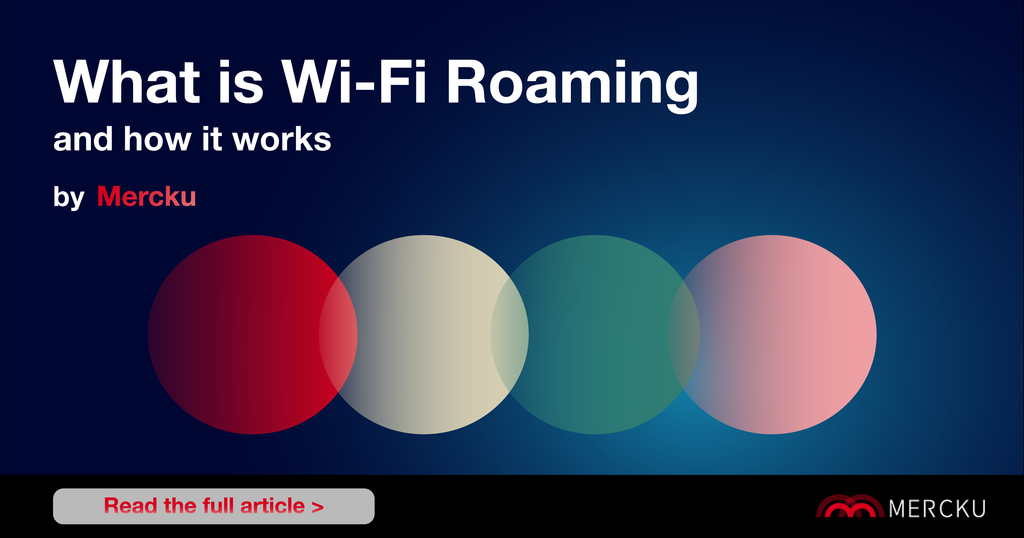
What is Wi-Fi Roaming?
Have you ever wondered how your WiFi connection follows you around the building? This useful networking feature is called Roaming. WiFi roaming occurs when a wireless client device moves outside the usable range of one router or access point (AP) and connects to a different one. The client device automatically switches from one router (or access point) to another extender or mesh access point as needed to provide seamless connectivity. In this ideal scenario, you will not experience the inconvenience of choppy video calls and low download speeds when walking from one side of a building to another.
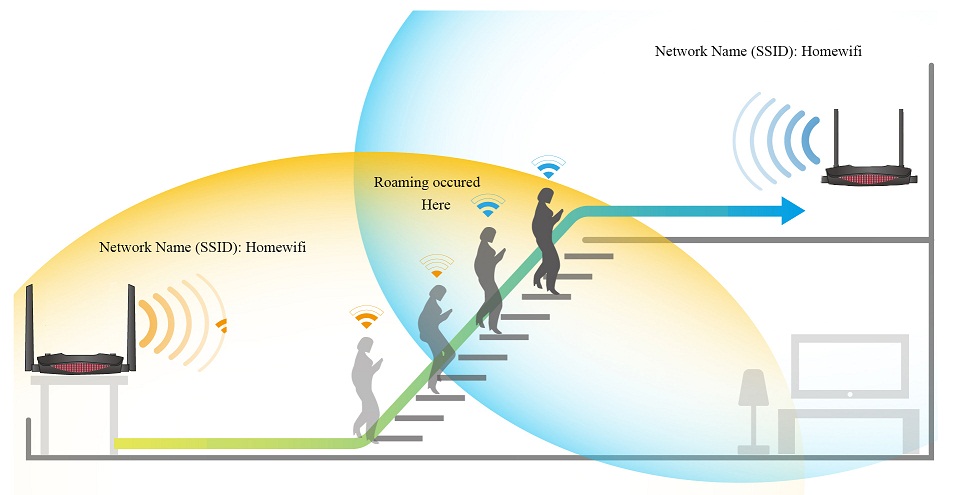
How does WiFi Roaming work?
In theory, WiFi roaming works similarly to cell phone roaming. You need to have multiple access points throughout the building – be it a hospital, school, workplace, etc., so that as soon as you’re near the outer limits of one of the access point’s range, your device is already in the range of another. In order to work seamlessly, all of the WiFi access points in the network need to be configured to use the same SSID (or network name) and the same login credentials.
However, WiFi roaming is decided by the client device, like your cellphone or laptop. WiFi Standards organizations (e.g. IEEE802.11 and WiFi Alliance) do not specify when or how a client device should roam. The wireless client device is responsible for deciding if it needs to roam and then detecting, evaluating, and roaming to another access point. There are 3 phases to this process:
Benefits of WiFi Roaming
Mobility is an essential feature of WiFi networks, but building a WiFi network that provides continuous coverage throughout a building can be difficult, especially as coverage demands grow. If you have ever experienced a sudden drop in connection speed while walking across a building, you know what we mean. The issue that most likely caused the drops in your connection was the network’s failure to support roaming. This issue can be solved by deploying the right network design.
WiFi Roaming allows you to freely move from room to room while your device automatically roams from one access point to another as necessary, intuitively choosing the strongest access point without dropping its WiFi signal, providing seamless connectivity. While there’s always a brief interruption when switching between networks – around half a second – when roaming, the duration of that interruption can be reduced to a minimum if the devices use the same WiFi network names (SSID’s), WiFi channels, and network keys.

Common Issues with Wi-Fi Roaming
There are two main issues when it comes to Wi-Fi Roaming:
Installing more access points in an area can potentially increase the chances of a client device connecting to the optimal access point.
However, proper WiFi roaming requires more than just good signal strength throughout coverage areas. A balance between the coverage of access points on both the 2.4 and 5 GHz bands is needed to make roaming work properly.
How to Optimize Your Network
For WiFi Roaming to be beneficial for the user, the user’s device must connect to the optimal access point, and the handover process between access points must be smooth. The user device should be connected to a particular WiFi network and should constantly be scanning for other access points with the same SSID. If an access point with a better signal is found, the user device should seamlessly connect to it and drop the previous connection. This handover should not result in a poor experience for the end-user.
As mentioned earlier, installing more access points can be an easy fix, but it doesn’t always work. Ensuring WiFi roaming is successful requires more than just strong signal coverage. It requires each access point’s coverage to be balanced on both the 2.4 and 5 GHz bands. But what does have “balanced” access points mean?
To optimize and balance access points, you can consider these tips:
Did you know that Mercku M2 and Mercku M6 routers support WiFi roaming?
Learn more about this and more on Mercku.com.
For more information about Mercku’s Connectivity Suite, our hardware and how you can partner with Mercku, please reach out to the team at connect@mercku.com
Thank you for reading our blog! Mercku Blogs covers the latest in wireless technology – subscribe to our newsletter to make sure you don’t miss our newest releases!
Partnering to Make Wi-Fi Available Everywhere
BlueportiQ, a wireless cloud-software manufacturer, today announced it has become a member of the Wireless Broadband Alliance (WBA). This membership underscores BlueportiQ’s commitment to the delivery of advanced Wi-Fi connectivity and robust security globally.
Founded in 2003, the vision of the Wireless Broadband Alliance (WBA) is to drive seamless, interoperable service experiences via Wi-Fi within the global wireless ecosystem. WBA’s mission is to enable collaboration between service providers, technology companies, cities, regulators and organizations to achieve that vision.
“We are delighted to welcome BlueportiQ to WBA membership,” said Tiago Rodrigues, CEO of WBA. “The BlueportiQ team shares our collective goals and we believe they will benefit from collaborating with the wider membership of WBA to provides secure, automatic and friction-free Wi-Fi around the world.”
BlueportiQ provides top-tier technology across multiple markets, including multifamily, hospitality, carriers, commercial, healthcare, and more. Its cloud-hosted software solution, VAULT™, provides global Wi-Fi roaming throughout multiple business locations over secure Wi-Fi access. VAULT enables frictionless onboarding Wi-Fi access to multiple user types when visiting these locations.
“BlueportiQ is humbled to join the WBA,” said Urbino Lobo, VP Sales EMEA for BlueportiQ. “We look forward to collaborating with the WBA workgroups to share our experience and use cases towards the mutual objective of simplified roaming technologies through seamless and interoperable Wi-Fi connectivity for all people globally.”
VAULT makes use of existing technology and does not require unique device onboarding or specialized Wi-Fi infrastructure compliance.
About BlueportiQ
BlueportiQ is a cloud-software manufacturer based in Massachusetts, USA. They develop unique patent-pending technology for device connectivity into Wi-Fi networks at any location in the globe. BlueportiQ is a recognized Wi-Fi NOW partner for roaming technologies.
About the Wireless Broadband Alliance
Wireless Broadband Alliance (WBA) is the global organization that connects people with the latest Wi-Fi initiatives. Founded in 2003, the vision of the Wireless Broadband Alliance (WBA) is to drive seamless, interoperable service experiences via Wi-Fi within the global wireless ecosystem. WBA’s mission is to enable collaboration between service providers, technology companies, cities, regulators and organizations to achieve that vision. WBA’s membership is comprised of major operators, identity providers and leading technology companies across the Wi-Fi ecosystem with the shared vision.
WBA undertakes programs and activities to address business and technical issues, as well as opportunities, for member companies. WBA work areas include standards development, industry guidelines, trials, certification and advocacy. Its key programs include NextGen Wi-Fi, OpenRoaming, 5G, IoT, Testing & Interoperability and Policy & Regulatory Affairs, with member-led Work Groups dedicated to resolving standards and technical issues to promote end-to-end services and accelerate business opportunities.
The WBA Board includes Airties, AT&T, Boingo Wireless, Broadcom, BT, Cisco Systems, Comcast, Deutsche Telekom AG, Google, Intel, Reliance Jio, SK Telecom and Viasat. For the complete list of current WBA members, click here.
Follow Wireless Broadband Alliance:
www.twitter.com/wballiance
http://www.facebook.com/WirelessBroadbandAlliance
https://www.linkedin.com/company/2919934/
SINGAPORE, 22 JULY 2021 – ANTlabs Pte. Ltd., an established network technology product and solutions provider for the hospitality industry, announces its partnership with Brantas Ltd., the leading integrator of hospitality technology in New Zealand and The Pacific. Both companies have been in the industry for more than two decades, thus combining long experience and expertise in providing better cutting-edge technology for its customers.
As more places are opening and people are returning to public venues, the expectation of getting seamless and good connectivity for their devices also increases. In addition, users now expect to stream their content, and traffic demand ballooned as more people go online for practically anything they need. ANTlabs gateways make handling such connectivity demands easy with their product features such as Advanced Quality of Service, Personal Area Network, and Security modules. Brantas found these helpful in managing their customers’ connectivity expectations.
“The addition of ANTlabs’ unique Guest Internet Access Gateway solution allows us to offer an end to end, turnkey package to aged- and health care facilities, hotels, conference centres, sports stadiums and other hospitality venues,” says Jan Strijker, General Manager of Brantas.
“Soon, Brantas will announce the completion of some high-profile implementations of ANTlabs in three countries in the region that Brantas services”, Strijker added.
Brantas uses the ANTlabs Service Platform as a managed solution for managing multiple venues, and it comes with 24/7 guest support.
“Partnering with Brantas will definitely strengthen our presence in New Zealand and the Pacific Islands. As a result, the users in this region will get to experience the superior and high-quality internet bandwidth management solution offered by ANTlabs and Brantas,” according to Kelvin Poh, ANTlabs Director for Global Partner Engagement.
……………………………………
About ANTlabs Pte Ltd.
ANTlabs Pte Ltd develops a wide range of network edge appliances, cloud-based platforms, bare metal appliances or virtualized telcos network infrastructure solutions for various business divisions and applications. ANTlabs was established in 1999 and headquartered in Singapore; its focus is providing products and solutions for the hospitality, large venues, telcos, and ISP industries. ANTlabs has established itself as a market leader, commanding a solid regional presence in Singapore with branch offices in South Korea, the Philippines, and United Arab Emirates (UAE).
About Brantas Ltd
Brantas was established in 2002 and has since developed into a leading hospitality technology solution provider. On the 1st of April 2021, Brantas was acquired by Baycom Communications. Brantas’ portfolio includes but is not limited to NEC PBX, CETIS Phone Handsets, FCS Workflow Management software. Together with Baycom, Brantas can offer Voice and Data Connectivity services and a New Zealand wide support network.
Excited members of Kansas-based cooperative embrace managed Wi-Fi offerings delivered via the full Revenue EDGE solution, including subscriber-facing applications in EDGE Suites—particularly the home-network security services in ProtectIQ
SAN JOSE, CA – July 22, 2021 – Calix, Inc. (NYSE: CALX) today announced that SCTelcom is continuing to dramatically transform its business and grow its value with Revenue EDGE. Most recently, SCTelcom achieved an extraordinary 200 percent increase in the adoption of its premium-level managed Wi-Fi package in just seven months and a 95 percent take rate of ProtectIQ®—a value-added EDGE Suites application that secures members’ home networks—only one year after launching. SCTelcom’s formula for success consists of leveraging the full Revenue EDGE solution: bundling ProtectIQ alongside the cutting-edge Wi-Fi 6 certified GigaSpire BLAST® system and the cooperative’s newly branded CommandIQ® mobile app, SCT WiFiConnect, into its three tiers of managed Wi-Fi service offerings. SCTelcom then leverages the real-time data insights of Calix Marketing Cloud to identify, segment, and target members based on their usage, resulting in experience-based offerings that excite members across southcentral Kansas and northcentral Oklahoma and drive new, recurring revenue streams.
A longtime Calix customer, SCTelcom began rolling out the full Revenue EDGE solution in 2019 to differentiate its brand and expand into new service territories. Since then, SCTelcom has continued to build on its early and impressive results, and now boasts a 76 percent mobile app attachment rate that gives members everything they need to control their home Wi-Fi experience at their fingertips and provides SCTelcom with a direct and branded communications channel to develop deep and continuous relationships with members. The managed Wi-Fi experience includes the capabilities of ProtectIQ which provides advanced security protection from threats such as malware, ransomware, and other types of increasingly sophisticated cyberattacks. By bundling ProtectIQ into all three tiers of its managed Wi-Fi service offerings, SCTelcom takes the complexity out of cybersecurity for its members.
A 2020 online survey of more than 1,200 broadband subscribers conducted by Calix, together with global technology analyst and advisory firm MOOR Insights & Strategy, found that most consumers inherently trust their service providers to protect their personal data. Moreover, most respondents identified their service providers as a top choice for home network security solutions.
“We recognize that whole home network security is no longer an option—it’s an absolute requirement as people spend more time working, learning, and entertaining online,” said Carla Shearer, CEO and general manager for SCTelcom. “We chose to include ProtectIQ with all three tiers of our managed Wi-Fi service offerings to differentiate from the competition with a highly sophisticated yet simple to use application that provides peace of mind to our members who are increasingly concerned about their online security. By leveraging the full power of the Revenue EDGE, we have seen a tremendous take rate of this value-added service in just one year, contributing to our overall 20 percent increase in managed Wi-Fi services adoption among our members.”
SCTelcom is further reducing operating expenses with the actionable insights from Calix Support Cloud. Remote management and troubleshooting capabilities, thanks to the seamless integration between SCT WiFiConnect and Support Cloud, provide unprecedented in-home network visibility, enabling customer support representatives to resolve issues quickly and proactively. As a result, SCTelcom has also reduced the number of inbound calls related to SSID password resets—the main reason for member-related support calls—and cut truck rolls by 30 percent in a single year.
SCTelcom leans on the expertise of Calix Premier Customer Success Services to accelerate time to value, implement best practices, and drive service adoption to maximize revenue. SCTelcom is applying these lessons, backed by the real-time data insights of Marketing Cloud, to successfully identify, segment, and target members based on their usage to help drive adoption of ExperienceIQ™, another EDGE Suites application that will excite members with enhanced parental control capabilities to block content or applications, set usage limits, and view usage information.
“SCTelcom is an innovative leader using the Revenue EDGE portfolio to its fullest potential, harnessing the power of the integrated Calix Cloud coupled with the convenience of mobile apps to simplify its operations, excite members with new, revenue-generating services, and grow its business,” said Michael Weening, president and chief operating officer for Calix. “This is what service providers of any size can accomplish when they embrace the power of the platform. Armed with real-time data and mobile notifications that provide a direct communication channel to members, SCTelcom is fueling rapid growth, creating seamless experiences and delighting members with value-added services for their connected home. As a trusted partner, we are thrilled to support SCTelcom’s ongoing success.”
Watch Carla Shearer’s session at ConneXions to learn more about SCTelcom’s journey with Calix, and view a replay of our recent webinar, “How to Offer the Premium Services That Subscribers Want.”
IEEE 802.11ah Solution Redefines IoT Connectivity with Fastest 8MHz Channel Throughput, Lowest Power Consumption and Smallest Size
SYDNEY and IRVINE, Calif., July 13, 2021 – Morse Micro, a fabless semiconductor company reinventing Wi-Fi® for the Internet of Things (IoT), today announced the availability of Wi-Fi HaLow system-on-chip (SoC) and module samples to early access partners and key customers. These samples, combined with Morse Micro’s easy-to-use evaluation kits, give developers the opportunity to evaluate the market-leading throughput, power efficiency and extended range of the company’s Wi-Fi HaLow solutions.
Morse Micro’s comprehensive Wi-Fi HaLow portfolio includes the industry’s smallest, fastest and lowest power IEEE 802.11ah compliant SoCs. The MM6104 SoC supports 1, 2 and 4 MHz channel bandwidth. The higher performance MM6108 SoC supports 1, 2, 4 and 8 MHz bandwidth and is capable of delivering tens of Mbps throughput to support streaming HD video. These Wi-Fi HaLow SoCs provide 10x the range, 100x the area and 1000x the volume of traditional Wi-Fi solutions.
Using narrow frequency bands in the unlicensed sub-1 GHz spectrum outside the highly congested 2.4 GHz traditional Wi-Fi band, Wi-Fi HaLow signals penetrate obstacles more easily and can extend beyond 1 km, connecting far-flung IoT devices across residential, retail, office park, campus, warehouse and factory environments. Developed specifically for the IoT and supporting the latest WPA3 security, a single Wi-Fi HaLow access point (AP) can connect up to 8,191 devices, simplifying network deployment and reducing costs.
“The massive capacity and extended range of our Wi-Fi HaLow solution, combined with market-leading power efficiency and 8MHz channel throughput, will redefine Wi-Fi connectivity for the IoT,” said Michael De Nil, co-founder and chief executive officer at Morse Micro. “As a co-chair of the Wi-Fi HaLow Task Group, Morse Micro is actively promoting Wi-Fi Alliance certification and progressing in the HaLow certification program. By delivering IEEE 802.11ah-compliant SoC and module samples for evaluation, we’re helping our partners and customers accelerate the market shift to Wi-Fi HaLow technology.”
Morse Micro’s standards-based Wi-Fi HaLow solutions leverage the industry’s most ubiquitous wireless protocol, Wi-Fi, to expand connectivity across the IoT ecosystem and overcome the fundamental weaknesses of existing wireless technologies by offering ultra-low power, longer range and secure connections at much higher capacities. Morse Micro’s diverse portfolio of SoCs, modules, software, IP and patents is playing a critical role in accelerating Wi-Fi HaLow deployment. The company’s Wi-Fi HaLow solutions address commercial, residential and industrial IoT markets in applications such as access control, security cameras, industrial automation, retail and mobile devices at throughputs and ranges that will enable new IoT use cases.
Purpose-Built SoCs for Wi-Fi HaLow Connectivity
Designed in compliance with the IEEE 802.11ah standard, Morse Micro’s Wi-Fi HaLow SoC family is poised to redefine low-power, long-reach Wi-Fi connectivity for the IoT. MM6108 and MM6104 SoCs provide a single-chip Wi-Fi HaLow solution incorporating the radio, PHY and MAC and offering data rates that range from tens of Mbps to hundreds of Kbps at the farthest range. The radio supports operation in sub-GHz ISM bands worldwide between 750 MHz and 950 MHz.
The MM6108 and MM6104 RF interface provides the option to use on-chip amplification for typical low-power, low-cost IoT devices, or an additional external PCB-mounted power amplifier (PA) or front-end module (FEM) for ultra-long-reach applications. The RF receiver utilizes a high-linearity low-noise amplifier (LNA).
Morse Micro’s low-power IC design, combined with the IEEE 802.11ah standard, enables extended sleep times and lower power consumption for battery-operated client devices, achieving longer battery life durations than other existing IEEE 802.11a/b/g/n/ac/ax generations.
Morse Micro MM6108 and MM6104 SoCs Key Features
Availability
Morse Micro’s Wi-Fi HaLow evaluation kits, as well as samples of the MM6108 and MM6104 SoCs and modules, will be available to early access partners and key customers starting late July. For more information about Morse Micro’s Wi-Fi HaLow solutions and to pre-order evaluation kits, visit morsemicro.com.
Morse Micro will demonstrate its Wi-Fi HaLow technology and evaluation kits at ISC West 2021, July 19-21, 2021. Contact Morse Micro to schedule a meeting at morsemicro.com/contact-us/.

Wi-Fi 6 is built to address the challenges of today’s connectivity landscape, leveraging new or enhanced versions of technologies like OFDMA and bi-directional MU-MIMO to manage the multi-user, simultaneous usage patterns that define modern Wi-Fi networks. However, peak Wi-Fi 6 performance depends on both expert implementation of these tools and the ability to use them together. Ensuring the right tool is applied to the right requirement and optimizing the combination of capabilities at any given moment has elevated the role of the network scheduler to one of singular importance. Simply stated, performance of the Wi-Fi 6 network scheduler is the best predictor of overall Wi-Fi 6 performance in a modern network.
Recently, Qualcomm Technologies, Inc. demonstrated, through technical analysis, the importance of a high-performance network scheduler and published that analysis in a new research-based whitepaper. Our decades-long pedigree, derived from intensive research and development, yields a highly optimized network scheduler delivering significant performance advantages when compared to either legacy single-user scenarios or to competitors’ offerings.
The analyses were developed to measure both throughput and latency, key performance indicators across multiple intense usage network deployments. In one use case, the analysis illustrates the impact of Qualcomm Technologies’ scheduling in delivering airtime fairness (as measured in throughput per device) in a mixed client environment with both Wi-Fi 6 and Wi-Fi 5 devices.
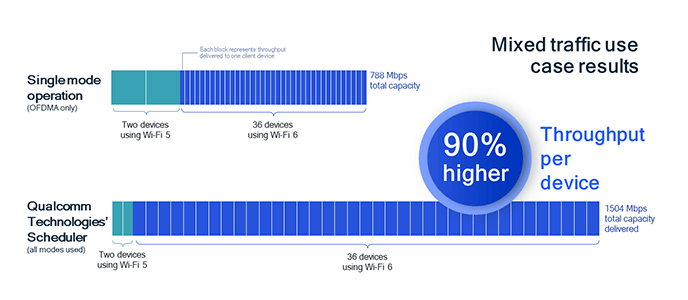
Analysis conducted in Qualcomm Technologies’ labs.
Equal airtime fairness in mixed client environments is a critical factor in delivering a seamless Wi-Fi experience. Qualcomm Technologies set out to determine the impact our high-performance scheduler had on such a scenario. The results show an equal allocation of capacity, providing faster connections across all devices – Wi-Fi 6 and legacy – resulting in a significant performance boost per device. With up to 90 percent higher throughput per device, every user’s connectivity experience improved.
To further illustrate the performance of a Qualcomm Technologies’ scheduler, a second analysis was constructed with two scenarios. In these scenarios, the performance results between an access point based on the Qualcomm Networking Pro Series Wi-Fi 6 platform and a competitor’s Wi-Fi 6 access point were compared. These scenarios ran latency-sensitive real-time traffic, side by side, with heavy uplink traffic across the same network.
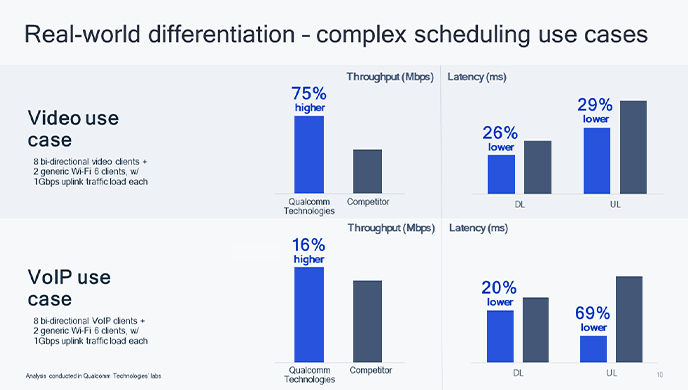
Analysis conducted in Qualcomm Technologies’ labs.
These analyses highlight implementation superiority. They also demonstrate the significant role our highly optimized scheduler plays in the real-time balancing between OFDMA use for the benefit of multiple users with relatively small payloads or MU-MIMO for multiple users with large payloads without having to sacrifice on either throughput (with an increase of up to 75 percent where throughput is the KPI) or latency (with an overall decrease of up to 69 percent in use cases where latency is the KPI).
Overall, these analyses clearly illustrate that the full performance benefits of Wi-Fi 6 are only achieved through high-performance network scheduling. Qualcomm Technologies’ highly differentiated high-performance Wi-Fi 6 network scheduler is offered across our networking product portfolios, supporting our customers to deliver leading-edge connectivity in the home, school, public, and enterprise environments. From video conferencing and gaming to voice and beyond, unlocking the full benefits Wi-Fi 6 is transforming industries and empowering new and improved experiences for users.
HSINCHU, Taiwan, 2021 – Edgecore Networks, a leading provider of traditional and open network solutions for enterprises, data centers, and telecommunication service providers, is pleased to announce the launch of a series of open Wi-Fi access points preinstalled with the Telecom Infra Project (TIP) OpenWiFi image. Edgecore’s TIP OpenWiFi-ready access points offer users an open platform that works straight out of the box and which is also highly customizable. Edgecore cooperates with other members in the TIP OpenWiFi ecosystem to accelerate the pace of innovation in the Wi-Fi market by creating cost-effective disaggregated open source solutions aimed at improving global connectivity.
Edgecore Networks joined TIP’s Wi-Fi Project Group in 2019 and has contributed technology and experience in hardware and software disaggregation. Edgecore is proud to launch a range of open Wi-Fi access points preinstalled with TIP’s OpenWiFi image to further support the ecosystem, including two Wi-Fi 6 indoor access points, EAP101 and EAP102, three Wi-Fi 5 Wave 2 indoor access points, ECW5211-L, ECW5410-L, and SS-W2-AC2600, and one Wi-Fi 5 Wave 2 outdoor access point with optional cellular backhaul, OAP100. From SMB to MDUs to larger venues, Edgecore TIP OpenWiFi-ready access points can adapt to various usage and requirements. The all-in-one package allows users to save on time without the hassle of having to go through initial setup. If required, Edgecore products provide endless possibilities on its open platform for clients to expand accordingly. Furthermore, each access point has received multiple international certifications including FCC and CE, allowing each product to successfully enter local markets across numerous countries and regions.
Tengtai Hsu, Vice President of Edgecore Networks said, “As an active contributing member of TIP, Edgecore is excited about the positive collaboration that is being established among the members of the OpenWiFi ecosystem, which allows each member to excel in their area of expertise. Further, Edgecore highly prioritizes executing a roadmap that provides more high quality TIP OpenWiFi-ready products for adoption by the ecosystem. Edgecore is eager to utilize the synergy within the OpenWiFi ecosystem to develop, build, test, and deploy open, disaggregated, and standards-based solutions that deliver the high-quality connectivity that the world needs.”
“As a longtime TIP participant and supporter of disaggregation, Edgecore Networks is an active member in multiple project groups across TIP. We are excited to have Edgecore expand its support of TIP and its initiatives to include the OpenWiFi initiative,” said David Hutton, Chief Engineer, TIP.
Edgecore open Wi-Fi access points with TIP’s OpenWiFi image preinstalled are now available for order.
About Edgecore Networks
Edgecore Networks Corporation is a wholly owned subsidiary of Accton Technology Corporation, the leading networking ODM. Edgecore Networks delivers wired and wireless networking products and solutions through channel partners and system integrators worldwide for data center, service provider, enterprise, and SMB customers. Edgecore Networks is the leader in open networking, providing a full line of open 1G-400G Ethernet OCP Accepted™ switches, core routers, cell site gateways, virtual PON OLTs, optical packet transponders, and Wi-Fi access points that offer choice of commercial and open source NOS and SDN software.
For more information, visit wifi.edge-core.com or contact sales@edge-core.com.
– Former Liberty Global executive to oversee global go-to-market strategy
ISTANBUL – July 8, 2021 – Airties, the most widely deployed supplier of managed Wi-Fi solutions to service providers globally, today announced that it has appointed Nicolas Fortineau as Executive Vice President and Chief Marketing Officer.
“We are very proud to have Nicolas Fortineau join our senior leadership team,” said Philippe Alcaras, CEO of Airties. “Our mission is to empower service providers to deliver the best managed Wi-Fi experience for their customers, and Nicolas’ unique expertise will help us further deliver on that commitment. He brings a global operator’s perspective, extensive knowledge on the evolution of the connected home, and the ability to articulate a customer-centric vision. We look forward to what he will bring to our team, customers, and partners.”
“Connectivity is an essential part of daily life, and I am excited to join a company that is so relentlessly dedicated to helping operators improve the way people connect, work, play, and learn,” said Nicolas Fortineau, Executive Vice President and Chief Marketing Officer at Airties. “We are living through a profound transformation of users’ connectivity behaviours. It offers broadband operators a unique opportunity to satisfy those with a best-in-class user experience fuelled by innovation. Airties has always been recognized as the gold standard for operators seeking the best possible connectivity experience, and I am excited about playing my part to help continue and enhance that legacy of success and innovation.”
Mr. Fortineau will oversee Airties’ global marketing efforts including product marketing vision and go-to-market strategy. Prior to joining Airties, he spent more than a decade at Liberty Global, most recently serving as Product Director of Connectivity Platforms, where he oversaw their product development efforts for in-home connectivity across seven countries for both residential and SoHo customers. In this role, he led development efforts across networks, CPE, cloud services and data insights – leveraging the best of technology such as Wi-Fi, 5G, cloud computing, and artificial intelligence to help improve the lives of consumers. Mr. Fortineau previously served as head of product development for Liberty Global’s Wi-Fi product portfolio and ran operations throughout Europe, Asia, the U.S. and Africa during his career. He will report to Philippe Alcaras.
Airties’ technologies have been deployed by dozens of leading service providers across 4 different continents, and Airties Cloud actively manages more than 25 million homes. Airties was named the 2020 “Best Home Wi-Fi Solution” as part of the prestigious Broadband World Forum Awards. More information about Airties can be found at: www.airties.com.
About Airties
Airties is the most widely deployed provider of managed Wi-Fi solutions to operators around the globe. Airties Smart Wi-Fi portfolio includes Airties Edge, smart Wi-Fi software for gateways; Airties Cloud, a cloud-based management platform and its companion app, Airties Vision; and Wi-Fi mesh extenders. Operators turn to Airties for the design, implementation, and ongoing optimization of their customers’ broadband experience. Some of Airties’ customers include Altice USA, AT&T, Singtel, Sky, Telia, Telstra, Vodafone, and many others. More information is available at www.Airties.com.

The increased usage of smartphones, tablets, and IoT devices around the world is creating a growing demand for more reliable network coverage and higher and faster data transmission. Cellular networks such as 4G LTE use frequencies between 600MHz to 700MGz and 2.5GHz to 3.7GHz bands, allowing for waves to travel further and cover more area, but at the cost of lower speeds. As technological innovation persists, data consumption is only going to increase, and we need a way to make data transmission faster and more efficient. A promising technology that can be used for this purpose is millimetre wave, also referred to as mmWave.
Millimetre wave is the band of spectrum with frequencies between 30GHz to 300GHz. Compared to the frequencies used for cellular networks and Wi-Fi today, mmWave has significantly higher frequencies, which allows for higher data transfer speeds.
Well, higher frequency transmissions have greater bandwidth, which measures the data transfer capacity of a network in bits per second. This means that with mmWave technology, a greater amount of data can be transferred per second, resulting in much higher network speeds.
Millimetre Wave technology gets its name from the fact that the wavelengths of the 30GHz to 300GHz frequencies span a distance of 1 – 10 millimetres. This wavelength is significantly shorter than the radio waves currently used by smartphones, whose wavelengths are around several dozen millimetres. Currently, the mmWave technology is primarily used by radar systems and satellites, with its reach rapidly expanding to 5G cellular networks and remote sensing. Before we discuss the uses of mmWave technology and how it’s affecting the transmission of data, let us consider some of the advantages and disadvantages of using mmWave technology.
Millimetre wave technology has various applications, spanning industries like radio astronomy, remote sensing, satellites, military weaponry, security screening and telecommunications. Further advancements in mmWave open up the possibilities of creating many unique technologies more effective and efficient.
From a wireless communications’ standpoint, mmWave does support faster transmission. However, due to its shorter wavelength, its signal propagation of mmWave is relatively short, meaning it can travel less distance when compared to more lengthy radio waves. These characteristics of mmWave prove to be beneficial. Shorter transmission paths limit interference from neighbouring mmWaves that might overlap, which helps maintain high data transmission speeds. The short propagation distances can also increase the number of required access points in a given area, reducing the number of devices sharing bandwidth. Shorter wavelengths allow access point antennas to be smaller in size than other frequencies, making them useful for smaller data-transmitting devices.
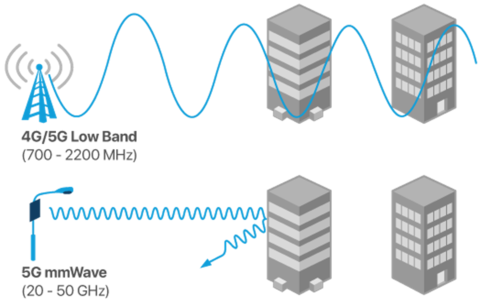
The main disadvantage of mmWave technology is that they are strongly affected by gases and moisture in the air, negatively affecting their range and strength. Rain and humidity reduce the waves’ signal strength and propagation distance. The propagation distance of mmWaves is already not as high as other frequencies, so all these obstacles prove to be quite damaging. Moreover, physical objects such as trees, walls, buildings, and people can weaken wave strength and reduce propagation. This disposition to signal loss is why mmWave technology is currently mostly used by devices that need to transfer data over shorter distances or devices that are located in obstacle-free areas.
Let’s further look into some of the more specific uses of mmWave technology in terms of 5G cellular network and remote sensing:
5G Cellular Network
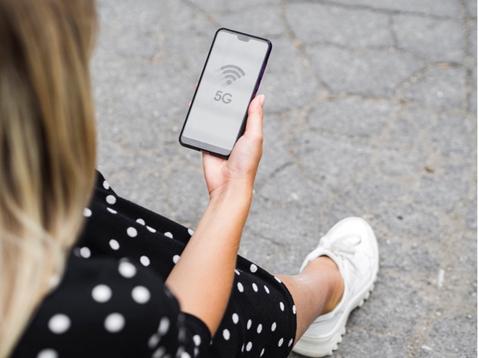
There are two types of 5G networks. The first one being mmWave, which is the type of 5G that is talked about in reference to high and improving network speeds. The second type is sub-6Hz, which is the 5G that most people worldwide are connected to today.
As discussed previously, mmWave refers to higher frequency bands in the 30GHz to 300GHz (although for 5G, mmWave will refer to frequency bands between 30GHz to 40GHz). Comparatively, sub-6Hz refers to lower frequencies under 6Hz. mmWave bands can transmit data faster, which is why they can support breakneck network speeds. Even though mmWave 5G networks are fast, the shorter wave propagation prevents them from being used in suburban and rural areas. People, walls, trees, and other obstructions in these areas make this issue worse. To use mmWave 5G, you must be within a block of a 5G tower, which isn’t a feasible thing for most communities. For the mmWave 5G network to be available for people in suburban and rural areas, there would need to be many more 5G towers installed, which is a considerable cost most carriers are unwilling to take on.
Because of mmWave’s limited range, it has been challenging to implement mmWave 5G in most areas around the world. Nonetheless, the technological advancements related to data transmission devices and antennas have allowed for mmWave to show lots of potential for 5G users in the future. Theoretically, mmWave 5G can deliver speeds up to 5Gb/s, compared to the current average of 40mb/s.
Remote Sensing:
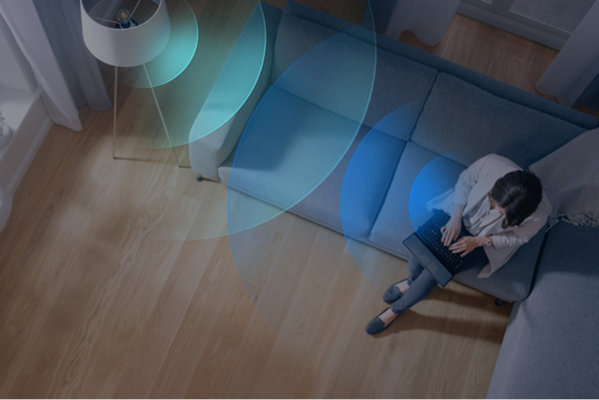
mmWave remote sensing incorporates the usage of mmWave radars, which are a type of sensing technology used to detect the movement and position of objects, and determine the velocity and angle of those objects. There are many different uses of remote sensing using mmWave radars. For example, mmWave radars are used by many automotive companies for traffic control. Moreover, mmWave radars can determine the distance between adjacent vehicles, which can help prevent collisions. The rate at which the mmWaves are reflected off a neighbouring vehicle could help determine the distance to the next vehicle.
Another use of mmWave’s remote sensing capabilities is health monitoring and human motion detection. mmWave signals are so sensitive that they can detect subtle changes in an environment, including some of the biological functions of the human body. For example, you could use a device that uses mmWave technology to monitor a user’s heartbeat and breathing without the use of sensors, wearables or implants. This is a unique technology in which the user would not have use any wearables to gather data.

Let’s also consider respiration rate monitoring. A signal is sent from the mmWave device out into the environment. When you inhale, your chest inflates, making the distance from the signal’s origin to its destination a tiny bit shorter. When you exhale, the signal needs to travel a little further. By monitoring these variances in the signal, your system could deduce and monitor your respiration rate. Over time, the algorithms in the system will learn what is normal for you and take motion into account (e.g. during exercise). So, for instance, if you have an allergic reaction and your respiration rate suddenly changes drastically, your system could be programmed to respond by dialing the emergency services.
For more information on Mercku’s remote sensing, check out our upcoming product: Mercku Wireless Intelligence Sensing (WISe)
Want to learn more about wireless sensing? Read more about our latest partnership with Aerial to provide best-in-class WiFi Sensing Services!
For more information about Mercku’s Connectivity Suite, our hardware and how you can partner with Mercku, please reach out to the team at connect@mercku.com
Thank you for reading our blog! Mercku Blogs covers the latest in wireless technology – subscribe to our newsletter to make sure you don’t miss our newest releases!